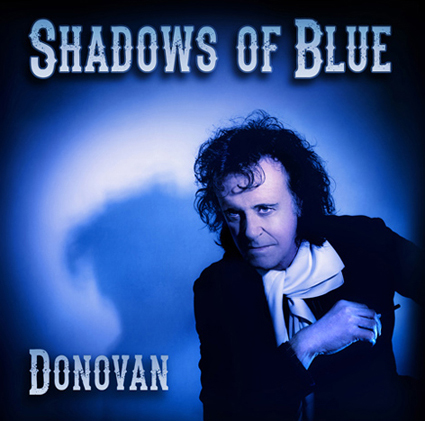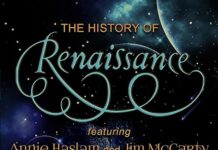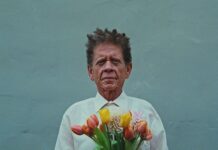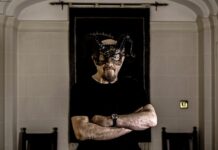Donovan — born Donovan Philips Leitch in Scotland in1946 — is one of those artists most fans know on a first name basis. More importantly, he is one of the early architects of the folk-to-psychedelic landscape of the 60s, recording songs like “Sunshine Superman,” “The Hurdy Gurdy Man,” “Mellow Yellow” and “Atlantis.”
This is a man who is not only featured in the D.A. Pennebaker Bob Dylan documentary Don’t Look Back, but also had Jimmy Page and John Paul Jones before they started Led Zeppelin play on his sessions.
He contributed a few lines of lyrics to “Yellow Submarine,” taught John Lennon and Paul McCartney both various finger-picking techniques, and was invited by the Beatles to join them at Abbey Road Studios for the final orchestral overdub session for “A Day In The Life.” Oh and, Donovan is a recent inductee into the Rock And Roll Hall of Fame.
To say I was honored to talk to Donovan about his new album, his career, how he finally found himself back in Nashville (where he recorded his latest release Shadows Of Blue), and the slippery slope of placing songs in films, would be an understatement.
~
I’m so happy to interview you sir, really. From your illustrious history to your new album Shadows Of Blue, which is killer by the way, there’s really so much to talk to you about.
Well, thank you. It might be odd for me to talk of my new album, but not really as the new work traces the history of rock from its early days up to now. So it’s a pleasure to do this really.
In reading your website, you specifically mention the Irish American country music connection, something I have heard Henry McCullough speak of too.
Yes, in doing this album I was tracing my own musical traditions and the history of the Irish Scots influence on popular music, the music and poetry that had come over from Ireland and Scotland with the three-four million immigrants in the mid 1800s and early 1900s. The Irish/Scots entering America made up ‘half’ of all immigration into the U.S. back then, no wonder our Celtic influence was so overwhelming.
How did you find yourself back in Nashville?
The great honor from my induction into The Rock and Roll Hall of Fame made me meditate on where all my music and much of modern popular music had come from. And how my career had begun in song publishing when I was eighteen when I was signed in 1964 by the pioneering music publisher Ralph Peer Jr. Ralph’s father, Ralph Peer, almost singlehandedly begun the country music recording world when he recorded the Carter Family and Jimmy Rodgers in 1928. My first single “Catch The Wind,” released in 1965 on Hickory Records out of Nashville, was covered by five major country artists: Dottie West, Buck Owens, Chet Atkins, Flatt & Scruggs and Glen Campbell.
So, I called Peer Music Nashville and arrived September 2012 to begin recording. After my induction into the Rock Hall last year, it was thought I would set out on the road around the world on a tour, but a voice inside reminded me: “Remember the seven songs you have kept all these years, the old cassette from the early seventies?” Then I went to my archive and there they were, four lost love laments, two Celtic cowboy dance tunes and a gospel rock road warrior song. Those are the first seven on Shadows Of Blue. I would write three more to join the seven.
It’s well known that the country players in Nashville are about the best around. Listening to Shadows, you really must be pleased with the results.
I’m knocked out with the results. I knew I would not be doing ‘straight country’ sounds as I am always making Donovan records and that means a ‘blend’. The players ‘got it’ right away, they knew what I was up to and knew I wanted a blend not just ‘old time’ styles, as I say.
When I arrived in Nashville I met Michael Knox (multi-Grammy Award-winning producer and son of rockabilly pioneer Buddy Knox). Michael is now part of the Peer Family in Nashville. I didn’t ask him to produce as I would do it, but I did ask him what studio and what players I should use. He said Treasure Isle Studios, where such great work has been recorded by top artists and Michael also suggested the players. I even invited my dear young chum from the 60s John Sebastian to play his harmonica on “The Harmonica Girl.”
On top of such great players I was also knocked out to meet Peter Coleman the engineer-in-command of Treasure Isle. He’s a Brit who has been through all the London studio experiences I had — a major plus for the success of these sessions. Peter and I knew the sound was to be how we did it in the Golden Age of the 60s. Peter was an ace!
In following all the great musicians who have had played on your records, could you a brief run down on a few of the more memorable legends that contributed to your recordings?
In the Golden Age of the 60s, I would enter the studios in London with the great producer Mickie Most with me. I was a solo not a band so Mickie and I had John Cameron arrange, for instance “Sunshine Superman.” John and I would meet before sessions and he’d listen to what I was doing on guitar, I’d play bass lines and rhythm patterns and melodies on guitar. I would suggest harpsichord and congas. Jimmy (Page, that is) was booked for that session as a session guy and he just knew what to do. The jazz sound of many of my grooves Jimmy picked up on.
Jack Bruce was different. I was producing the track and I left Jack to play exactly what he felt. With “Hurdy Gurdy Man.” John Paul Jones himself arranged and played bass. This was all before Zep was formed. It has been suggested Jimmy played the metal guitar sound and Bonham the drums on “Hurdy,” but John Paul and I say drums were Clem Cattin and Allan Holdsworth played the lead guitar. Bonham once said he played the drums on “Hurdy Gurdy” but John Paul says no. It might sound odd but I don’t recall exactly one hundred percent, those sessions were done so fast — three hours, three tracks. I seemed to remember two drummers on “Hurdy Gurdy” though. I have to say, my songs and quirky styles were very attractive to the best players.
Incidentally, I wanted to give “Hurdy Gurdy Man” to Hendrix who I had met when he first was brought over by Chas Chandler but Mickie Most said it was my next single. I then asked Hendrix to play the guitar on it but he was on one night stands on the road.
You also wrote the lines “sky of blue and sea of green” for “Yellow Submarine.” What’s the story behind that? Was there ever a chance you could have gotten a songwriting credit from The Beatles or was it more of a friend helping a friend?
It was a different time then, of course. On that particular Sunday, the Edgeware Road was silent and empty of cars. I was alone, recording new songs on my little Uher tape machine, when the doorbell rang. It was Paul (McCartney) on his own. He played a couple of tunes to me on his acoustic Martin six-string. One sang of a strange chap called Ola Na Tungee, Paul sang, “Blowing his mind in the dark with a pipe full of clay – No one can say… ” The tune was “Eleanor Rigby” but the words had not all come out yet; we songwriters sometimes sketch in the lyric with any old line then come back to it. Another song he sang to me was a little ditty with a chorus about a yellow submarine. He was missing a verse for the tune and asked me to get one in there. So I said, give me a minute, and left the room. What I came back with was not world-shattering but he liked it — “sky of blue and sea of green in our yellow submarine.”
We played a few more bits and pieces we were both working on, there in my little Japanese room, the sunlight filtering through the lace curtains. Then the doorbell rang again. I went to see and found a young bobby. He said a car had been left parked outside illegally, at an odd angle, the doors open and the radio still on.
Paul came to the door and the policeman said: ‘Oh, it’s you Mr. McCartney. Is it your car, sir? An Aston Martin Sportscar?’ The copper then said: “If you give me the keys I will park it for you.” Paul gave him the keys and the DB6 was parked – by the starstruck policeman, no less! In those days, a Beatle was treated like royalty. The copper came back with the keys and saluted. Saluted, would you believe?! Paul left soon after and drove off down the long and winding road.
I didn’t need a credit for the line I contributed to “Yellow Submarine” as all I did was re-write lines he had already. I also helped John Lennon with songs as I knew how to write what are wrongly called ‘Children’s Songs’. With John it was when the Beatles and I were in India and for John’s song to his mother Julia.
On Shadows Of Blue, I find there’s a lot of moments here where you are truly changing up your vocal — and I mean that as a compliment — I hear some Roy Orbison in “Resurrect,”(which has a stellar acoustic guitar sound, by the way. On “River of Ruin” yet again, you sound different. Are you aware that a song might need a different sounding vocal from you as well as different instrumentation sounds?
Thanks for the vocal comment. Rosanna Cash said about my voice on these tunes: “Your voice is still so romantic and welcoming and nuanced.” Then I sent the songs to David Lynch my ‘artist brother’ and he called the recordings, “A New Intimacy.” I have permission to use both quotes by the way (laughs).
Yes, I enter my songs and sing in different accents and character for the song. I am perhaps unique in that I have so many styles and genre songs and recording techniques. And well done Ralph for spotting the Orbison tribute in “Resurrect Your Love.” also “To Love You” is my Elvis tribute, as back when I wrote this for my Linda in the early 70s I wanted then to send it to Elvis. For vocal backgrounds I wanted The Jordanaires (Elvis’ male background singers) sound and asked the second engineer Sam Martin in Treasure Isle Studios to find a vocal trio that could sing like them. Sam found Michael Black and Gary Pigg who both had sung with the Jordanaires. The Elvis ballads background vocals I have always heard as sacred music and this trio on my Shadows certainly gave me and the songs all I wished for and more.
We touched on this a bit already, but how does it feel to be inducted into the Rock & Roll Hall of Fame?
It is a singular honor and I welcome it. Many of my fans thought it should have happened years ago, but the timing feels just right.
This is going to come from left field a bit, but as it happens to be one of my favorite best recent uses of a classic song in a movie, how does something like “Hurdy Gurdy Man” find its way into the movie Zodiac? Can you take us through that process, even slightly? Believe me, we have lots of music fans who are fascinated by song selection like this (me included) and why an artist says yes or no to films or TV shows using their songs.
From the very first, my songs were recognized by the film community and music superstars of film and TV requested the use of songs of mine. The advertising agencies also recognized my multi-genre writing and that my welcoming vocal performances were positive and life-affirming. I love film and am a great devotee of classic and some modern movies so I welcomed this interest for my songs from the start as I saw the potential of reaching younger audiences and so my mission to spread some peace and world unity would be furthered; film and TV reach many more than popular music.
The process though is a song is requested of Peer Music first. One needs to secure the Publishing Sync Permission. Then the actual music track can be requested from me or one of my labels, once the publishing is allowed. The actual scenes are sent to me and my MD in Donovan Music/Peer Music Nigel Elderton decides if it’s appropriate. Sometimes it’s good money; other times we give a student a chance to help the student into the world of film.
As to the content, at first my fans objected to the use, for example of “Atlantis” in “Goodfellas” as it was used in a killing scene. Of course, I knew it was a Scorsese film and I said whatever the maestro wants he can have! I had to explain to fans and media that it’s juxtaposition there, a gentle song highlighting a violent scene. “Zodiac” is a similar case.
I veto many requests and say no. The most important add that promoted my mission to contact young audiences and further ecological sanity, was the General Electric ad for wind energy where they requested and got “Catch The Wind”. You can see that ad on my website.
As you just completed a show in Maryland and I know you are traveling to Dublin at the end of October. What other shows are planned (if any) where people can come out to see you?
II am doing very little live performances. The Shadows of Blue release I am promoting in various ways to launch the new work. My 50th summer in music comes up in 2015 and let your readers know to watch my website and Facebook this year for news.
The music business has certainly changed through the years. As someone with your ‘seasoning,’ what’s your take on how things are now making records, touring, being a musical legend in the wacky way the business seems to be heading.
IThough there are new ways of distribution but it’s a very difficult time for artists and songwriters to still get paid for their work. I ask all fans to download legally as all artists need the income and it’s not fair as we give you our best work and we only ask for under a dollar a track. ‘Sharing’ is a bad scene and yet the Web is a good scene for young bands and artists and composers as they can control their complete works and get direct to their fans.
I’ll leave you with this: There are changes but what will never change is…songs are always needed and recordings made. And ‘live’ will always be the best way to hear music.




















